An Experimental Multi-Target Tracking of AM Radio-Based Passive Bistatic Radar System via Multi-Static Doppler Shifts
Abstract
:1. Introduction
2. Problem Formulation
2.1. System Description
2.2. CBMeMBer Filter
2.3. Multi-Target Tracking Model
3. The Proposed Multi-Target Tracking Method
3.1. IC-UK-GM-CBMeMBer Filter
3.2. State Extraction and Cardinality Biass
4. Experimental Results
4.1. Experimental Configuration
4.2. Field Experimental Results
4.3. Simulation Results
5. Conclusions
Author Contributions
Funding
Institutional Review Board Statement
Informed Consent Statement
Data Availability Statement
Conflicts of Interest
References
- Griffiths, H.D.; Long, N.R.W. Television based bistatic radar. IEEE Proc. F Radar Signal Process. 1986, 133, 649–657. [Google Scholar] [CrossRef]
- Howland, P.E. Target tracking using television-based bistatic radar. IEE Proc. Radar Sonar Navig. 1999, 146, 166–174. [Google Scholar] [CrossRef]
- Saini, R.; Cherniakov, M. DTV signal ambiguity function analysis for radar application. IEE Proc. Radar Sonar Navig. 2005, 152, 133–142. [Google Scholar] [CrossRef]
- Saini, R.; Cherniakov, M. Investigation of digital TV-terrestrial signal for radar application. In Proceedings of the 2002 11th European Signal Processing Conference, Toulouse, France, 3–6 September 2002; pp. 1–4. [Google Scholar]
- Howland, P.E.; Maksimiuk, D.; Reitsma, G. FM radio based bistatic radar. IEE Proc. Radar Sonar Navig. 2005, 152, 107–115. [Google Scholar] [CrossRef] [Green Version]
- Harms, H.A.; Davis, L.M.; Palmer, J. Understanding the signal structure in DVB-T signals for passive radar detection. In Proceedings of the 2010 IEEE Radar Conference, Arlington, VA, USA, 24 June 2010; pp. 532–537. [Google Scholar]
- Li, X.; Zhao, C.; Lu, X.; Wei, W. DA-PMHT for Multistatic Passive Radar Multitarget Tracking in Dense Clutter Environment. IEEE Access 2019, 7, 49316–49326. [Google Scholar] [CrossRef]
- Poullin, D.; Palmer, J. Passive detection using digital broadcasters (DAB, DVB) with COFDM modulation. IEE Proc. Radar Sonar Navig. 2005, 152, 143–152. [Google Scholar] [CrossRef]
- Daun, M.; Nickel, U. Tracking in multistatic passive radar systems using DAB/DVB-T illumination. Signal Process. 2012, 92, 1365–1386. [Google Scholar] [CrossRef]
- Min, L.; Jianxin, Y. Target tracking in time-division-multifrequency-based passive radar. IEEE Sens. J. 2020, 20, 4382–4394. [Google Scholar]
- Thomas, J.M.; Griffiths, H.D.; Baker, C.J. Ambiguity function analysis of digital radio mondiale signals for HF passive bistatic radar. Electron. Lett. 2006, 42, 1482–1483. [Google Scholar] [CrossRef]
- Thomas, J.M.; Baker, C.J.; Griffiths, H.D. DRM signals for HF passive bistatic radar. In Proceedings of the 2007 IET International Conference on Radar Systems, Edinburgh, UK, 15–18 October 2007; pp. 1–5. [Google Scholar]
- Fabrizio, G.; Colone, F.; Lombardo, P.; Farina, A. Adaptive beamforming for high-frequency over-the-horizon passive radar. IET Radar Sonar Navig. 2009, 3, 384–405. [Google Scholar] [CrossRef]
- Willis, N.J.; Griffiths, H. Advances in Bistatic Radar; SciTech Publishing: Raleigh, NC, USA, 2007. [Google Scholar]
- Yu, D.; Ma, H.; Cheng, L.; Li, Y.; Qin, Y.; Yin, S.; Chen, W. Method and field experiment of target tracking via multistatic Doppler shifts in high-frequency passive radar. IET Radar Sonar Navig. 2016, 10, 1201–1212. [Google Scholar] [CrossRef]
- Malling, L.R. Radio Doppler effect for aircraft speed measurements. Proc. IRE 1947, 35, 1357–1360. [Google Scholar] [CrossRef]
- Fried, W.R. Principles and performance analysis of Doppler navigation systems. IRE Trans. Aeronaut. Navig. Electron. 1957, 4, 176–196. [Google Scholar] [CrossRef]
- Salinger, S.N.; Brandstatter, J.J. Application of recursive estimation and Kalman filtering to Doppler tracking. IEEE Trans. Aerosp. Electron. Syst. 1970, 4, 585–592. [Google Scholar] [CrossRef]
- Do, C.-T.; Van Nguyen, H. Tracking Multiple Targets from Multistatic Doppler Radar with Unknown Probability of Detection. Sensors 2019, 19, 1672. [Google Scholar] [CrossRef] [PubMed] [Green Version]
- Demars, C.D.; Roggemann, M.C.; Webb, A.J.; Havens, T.C. Target Localization and Tracking by Fusing Doppler Differentials from Cellular Emanations with a Multi-Spectral Video Tracker. Sensors 2018, 18, 3687. [Google Scholar] [CrossRef] [Green Version]
- Vo, B.-T.; Vo, B.-N.; Cantoni, A. The cardinality balanced multitarget multi-Bernoulli filter and its implementations. IEEE Trans. Signal Process. 2009, 57, 409–423. [Google Scholar]
- Sun, R.; Zhang, W.; Yao, B. Frame Arrival Detection for Low SNR Frequency Selective Fading Channels. In Proceedings of the 2018 IEEE/CIC International Conference on Communications in China (ICCC), Beijing, China, 16–18 August 2018; pp. 374–378. [Google Scholar]
- Kim, B.-S.; Jin, Y.; Lee, J.; Kim, S. Low-Complexity MUSIC-Based Direction-of-Arrival Detection Algorithm for Frequency-Modulated Continuous-Wave. Vital Radar 2020, 20, 4295. [Google Scholar] [CrossRef]
- Li, Y.; Ma, H.; Wu, Y.; Cheng, L.; Yu, D. DOA Estimation for Echo Signals and Experimental Results in the AM Radio-Based Passive Radar. IEEE Access 2018, 6, 73316–73327. [Google Scholar] [CrossRef]
- Vo, B.-N.; Singh, S.; Doucet, A. Sequential Monte Carlo methods or multi-target filtering with random finite sets. IEEE Trans. Aerosp. Electron. Syst. 2005, 41, 1224–1245. [Google Scholar]
- Mahler, R. Multi-target Bayes filtering via first-order multi-target moments. IEEE Trans. Aerosp. Electron. Syst. 2003, 39, 1152–1178. [Google Scholar] [CrossRef]
- Mahler, R. Statistical Multisource-Multitarget Information Fusion; Artech House: Norwood, MA, USA, 2007. [Google Scholar]
- Guldogan, M.B.; Lindgren, D.; Gustafsson, F.; Habberstad, H.; Orguner, U. Multi-target tracking with PHD filter using Doppler-only measurements. Digit. Signal Process. 2014, 27, 1–11. [Google Scholar] [CrossRef] [Green Version]
- Simon, J.; Uhlmann, J. Unscented filtering and nonlinear estimation. Proc. IEEE 2004, 92, 401–422. [Google Scholar]
- Vo, B.-N.; Ma, W.K. The Gaussian mixture probability hypothesis density filter. IEEE Trans. Signal Process. 2006, 54, 11. [Google Scholar] [CrossRef]
- Vo, B.T.; See, C.M.; Ma, N. Multi-sensor joint detection and tracking with the Bernoulli filter. IEEE Trans. Aerosp. Electron. Syst. 2012, 48, 1385–1402. [Google Scholar] [CrossRef]
- The Comprehensive Shortwave Broadcasting Schedule. Available online: http://www.eibispace.de/ (accessed on 15 October 2014).
- The Short Wave Schedule. Available online: http://www.shortwaveschedule.com/ (accessed on 15 October 2014).




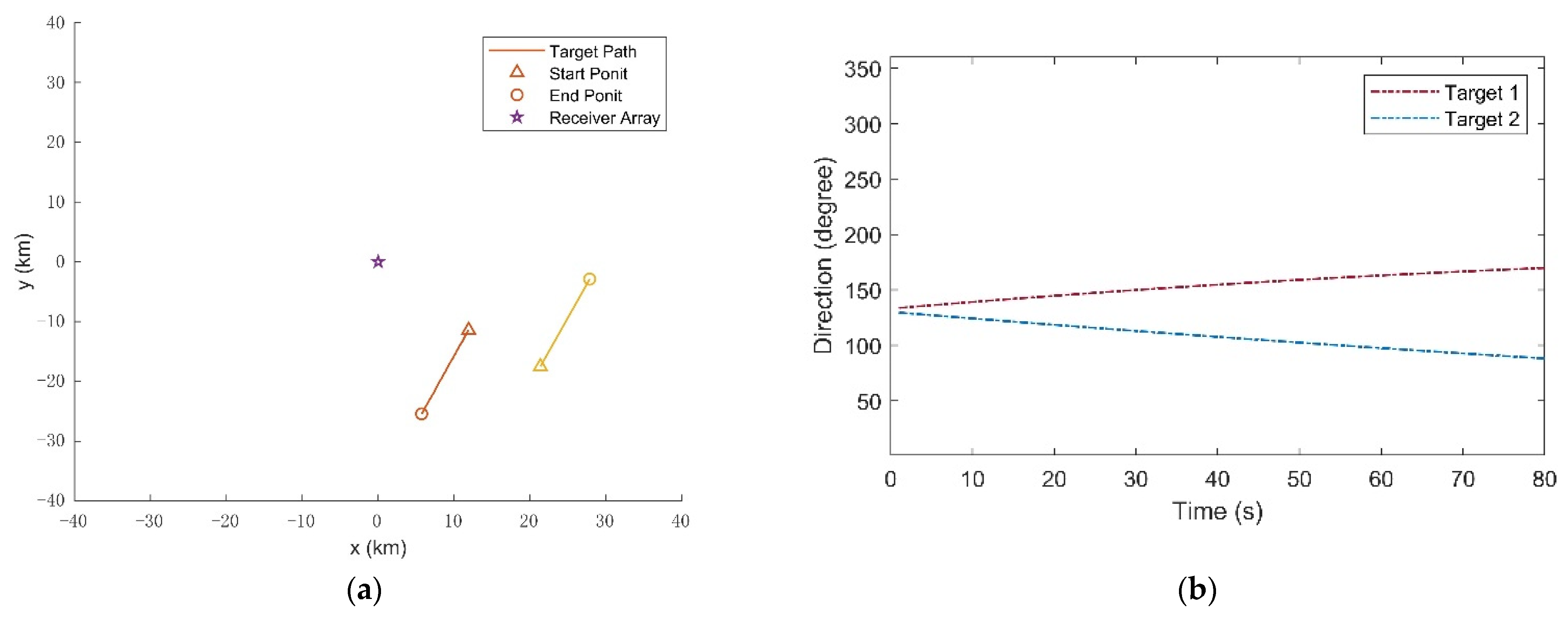
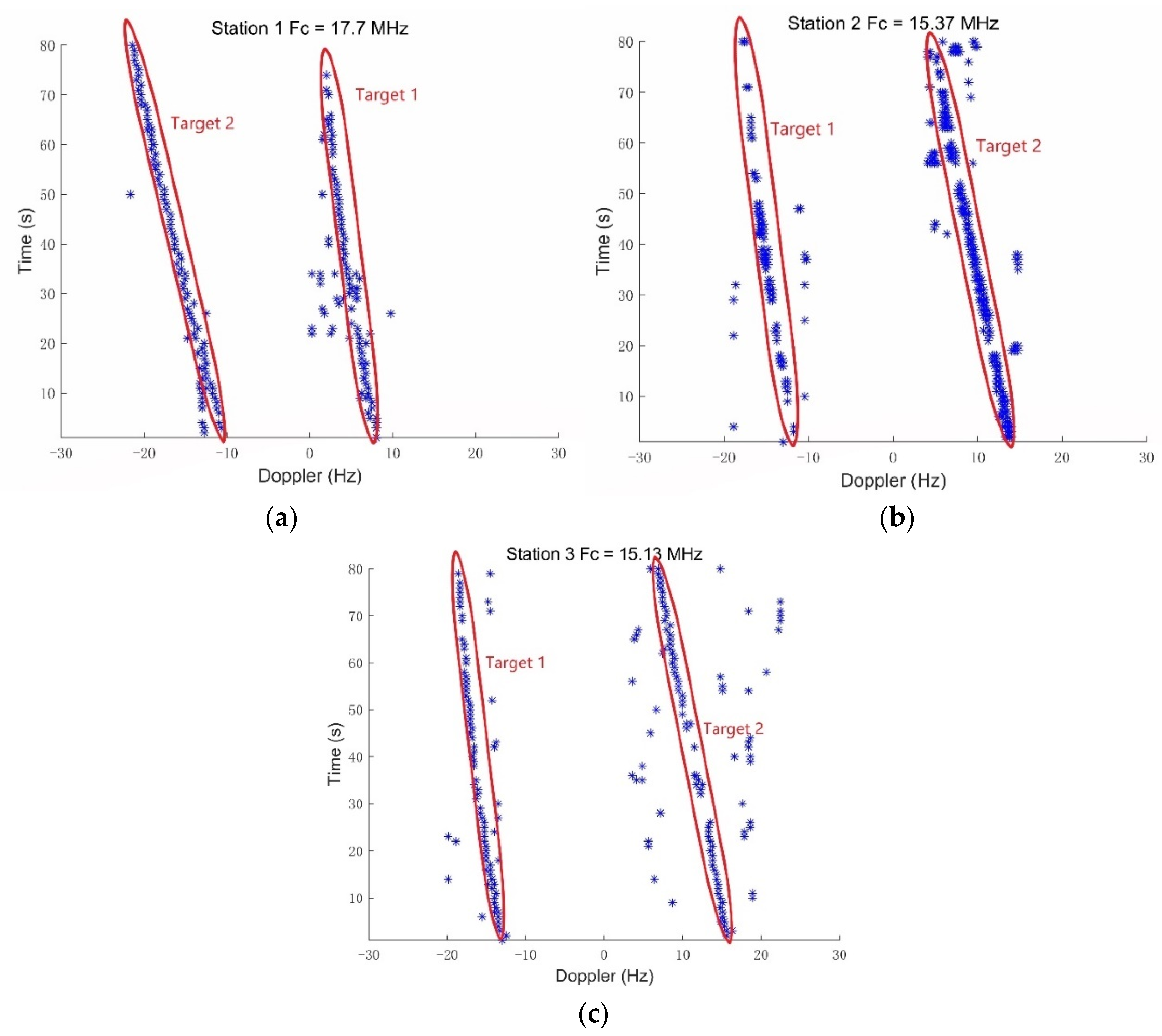



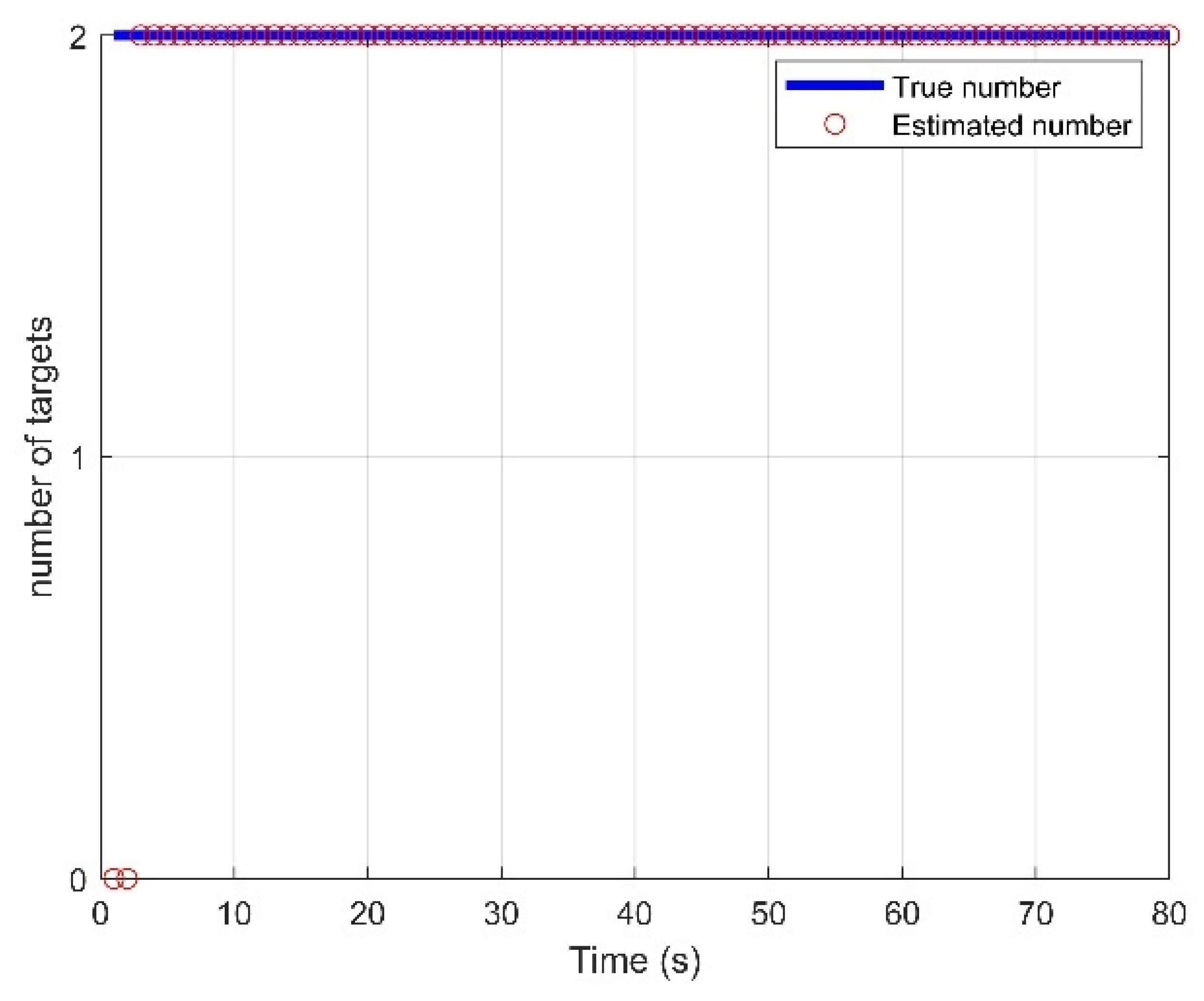
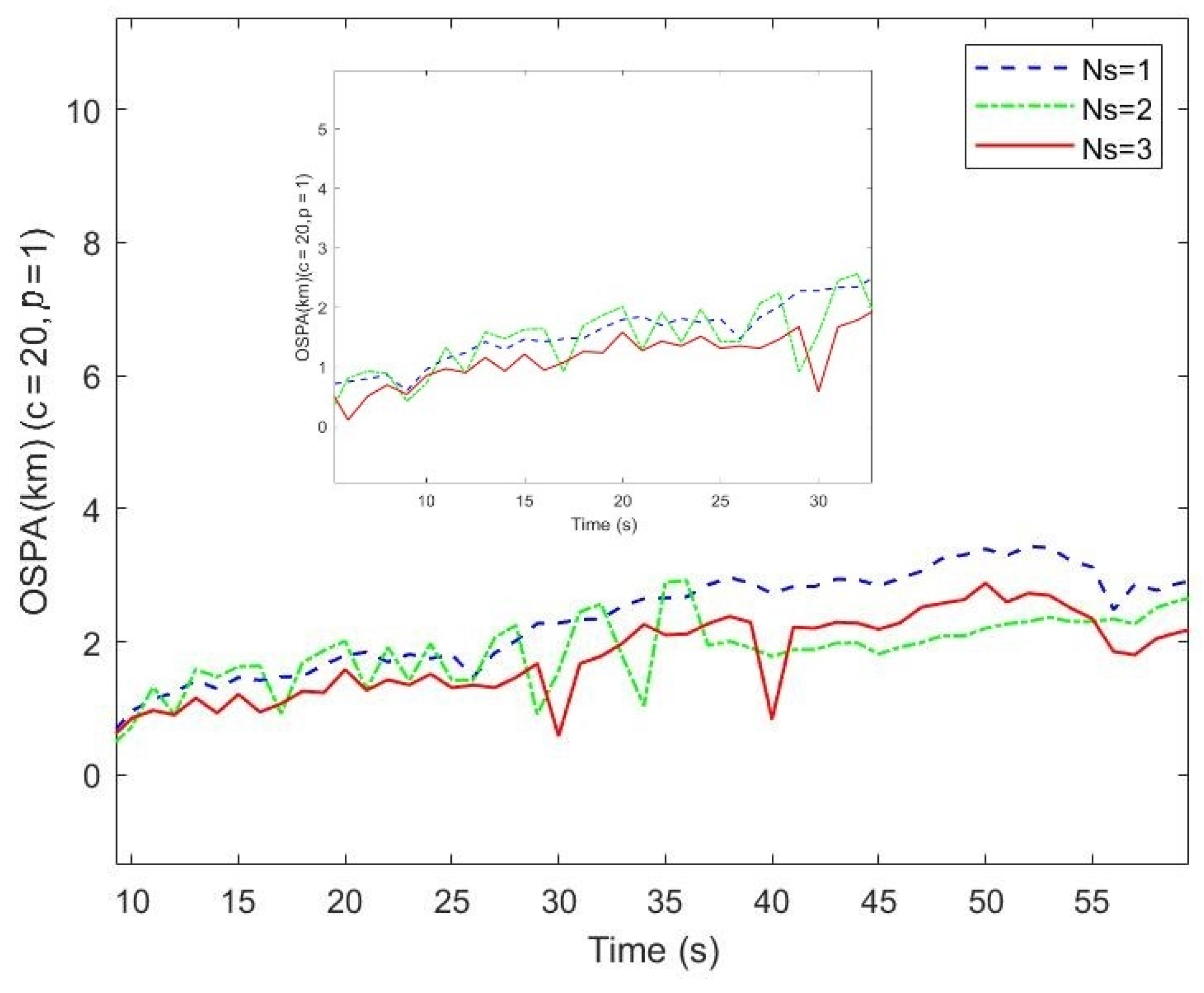
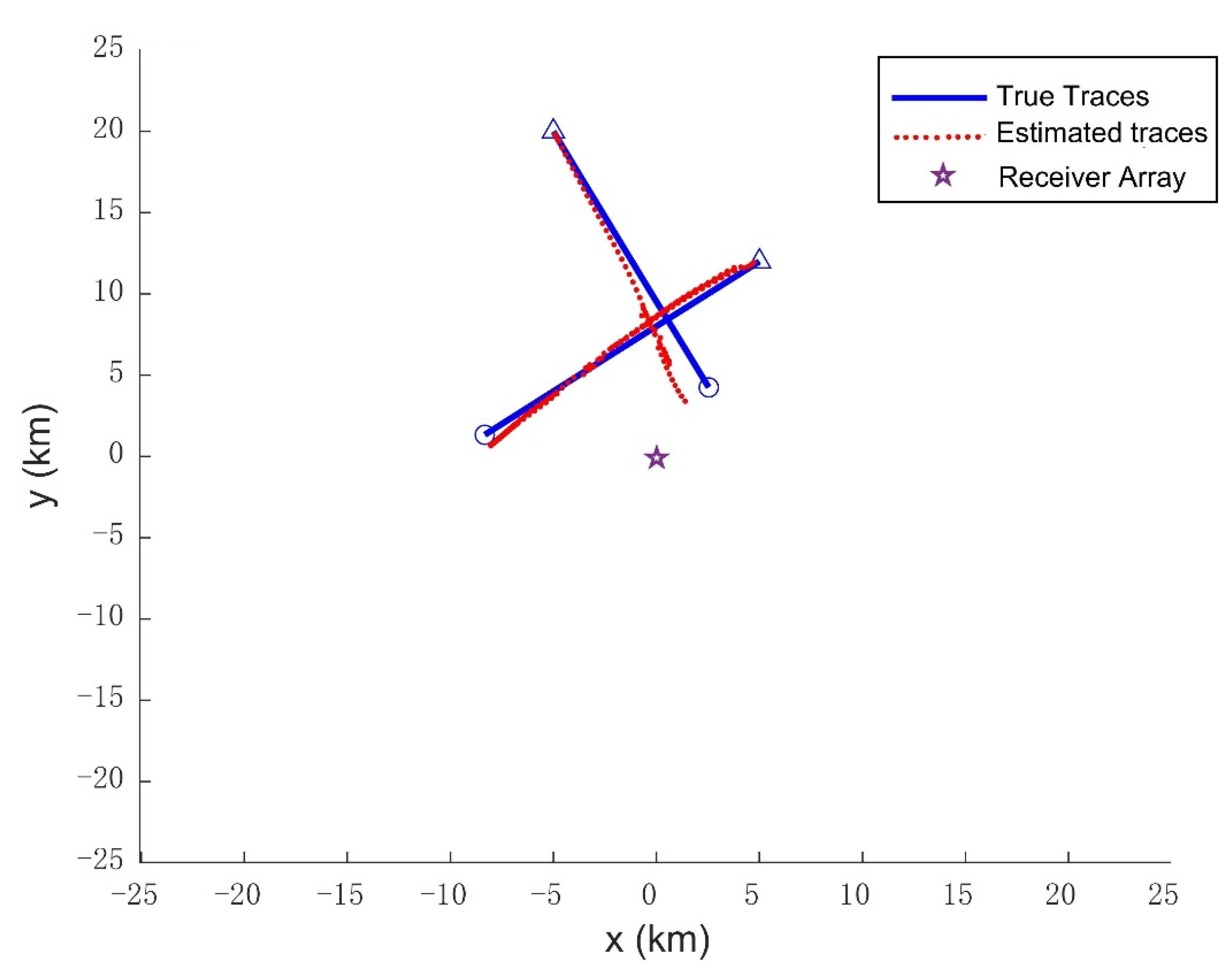
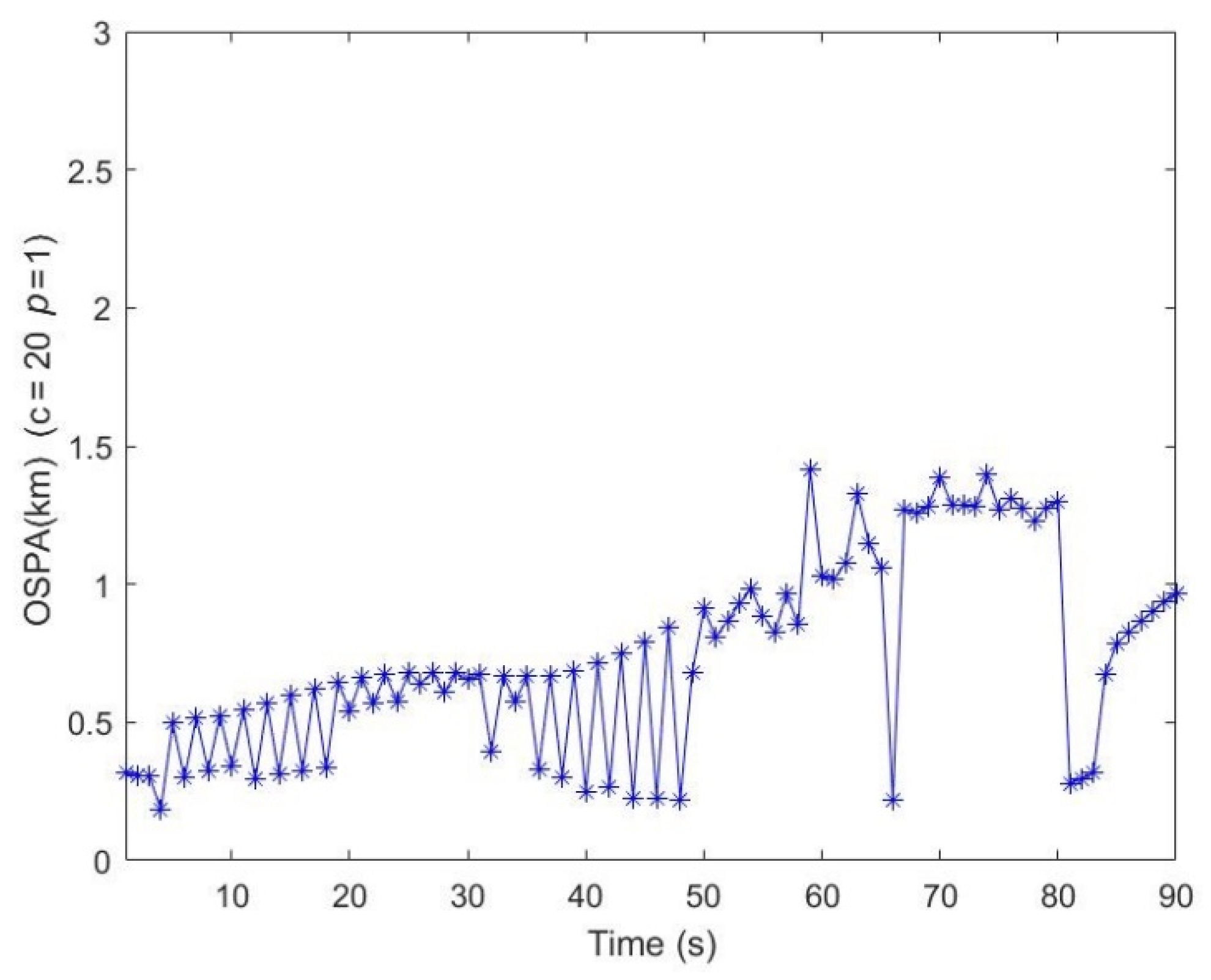
| for k = 1:Time duration predict surviving Gaussian components for i = 1:Mk |
for j = 1:Jk end end |
| construction of birth target Gaussian components using Equation (13) end update the legacy tracks for i = 1:Mk+1|k end |
| update the measurement-corrected tracks for freq = 1:Ns for i = 1: for j = 1: Mk+1|k each component constructs a set of sigma points and weights using Equation (22) to generate: end using Equations (18) and (19) end prune tracks end state extraction and cardinality bias using Equation (37) end |
| Station Serial Number | fc (kHz) | Station Name | Power (kW) | Latitude (deg) | Longitude (deg) | Distance (km) |
|---|---|---|---|---|---|---|
| Tx1 | 17770 | UDO | 250 | 17.25 | 102.48 | 1866 |
| Tx2 | 15370 | SZG | 100 | 38.04 | 114.28 | 842 |
| Tx3 | 15130 | BEI | 150 | 39.55 | 116.25 | 1027 |
| Item | Initial Position (km) | Initial Velocity (m/s) | Time of Birth (s) | Time of Death (s) |
|---|---|---|---|---|
| Target 1 | (−5,20) | (95, −200) | 1 | 80 |
| Target 2 | (5,12) | (−150, −120) | 1 | 90 |
Publisher’s Note: MDPI stays neutral with regard to jurisdictional claims in published maps and institutional affiliations. |
© 2021 by the authors. Licensee MDPI, Basel, Switzerland. This article is an open access article distributed under the terms and conditions of the Creative Commons Attribution (CC BY) license (https://creativecommons.org/licenses/by/4.0/).
Share and Cite
Zhou, X.; Ma, H.; Xu, H. An Experimental Multi-Target Tracking of AM Radio-Based Passive Bistatic Radar System via Multi-Static Doppler Shifts. Sensors 2021, 21, 6196. https://doi.org/10.3390/s21186196
Zhou X, Ma H, Xu H. An Experimental Multi-Target Tracking of AM Radio-Based Passive Bistatic Radar System via Multi-Static Doppler Shifts. Sensors. 2021; 21(18):6196. https://doi.org/10.3390/s21186196
Chicago/Turabian StyleZhou, Xueqin, Hong Ma, and Hang Xu. 2021. "An Experimental Multi-Target Tracking of AM Radio-Based Passive Bistatic Radar System via Multi-Static Doppler Shifts" Sensors 21, no. 18: 6196. https://doi.org/10.3390/s21186196






